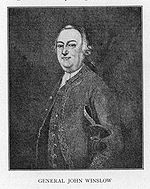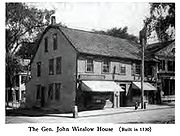
John Winslow (British army officer)
Encyclopedia


Edward Winslow
Edward Winslow was an English Pilgrim leader on the Mayflower. He served as the governor of Plymouth Colony in 1633, 1636, and finally in 1644...
, was an officer during the French and Indian War
French and Indian War
The French and Indian War is the common American name for the war between Great Britain and France in North America from 1754 to 1763. In 1756, the war erupted into the world-wide conflict known as the Seven Years' War and thus came to be regarded as the North American theater of that war...
.
John Winslow belonged to one of the most prominent families of New England; his great-grandfather Edward and grandfather Josiah Winslow
Josiah Winslow
Josiah Winslow was an American Pilgrim leader. He served as governor of Plymouth Colony from 1673 to 1680.Born in Plymouth Colony , he was son of Edward Winslow and Susanna White. In 1651 in London, with his father, he married Penelope Pelham, daughter of Herbert Pelham, the first treasurer of...
had both been governors of the Plymouth Colony
Plymouth Colony
Plymouth Colony was an English colonial venture in North America from 1620 to 1691. The first settlement of the Plymouth Colony was at New Plymouth, a location previously surveyed and named by Captain John Smith. The settlement, which served as the capital of the colony, is today the modern town...
. He was born in Marshfield, Massachusetts
Marshfield, Massachusetts
Marshfield is a town in Plymouth County, Massachusetts, United States, on Massachusetts's South Shore. The population was 25,132 at the 2010 census.See also: Green Harbor, Marshfield , Rexhame, Marshfield Hills, and Ocean Bluff and Brant Rock....
in 1703 as son of Sarah and Isaac Winslow. In 1725, he married Mary Little, a descendant of Pilgrim Richard Warren
Richard Warren
Richard Warren was a passenger on the Mayflower in 1620. He settled in Plymouth Colony and was among ten passengers of the Mayflower landing party with Myles Standish at Cape Cod on November 11, 1620...
. They had three children: Josiah, Pelham and Isaac Winslow. One of his slaves was Briton Hammon
Briton Hammon
Briton Hammon was a slave in the middle of the 18th century, who, after leaving his master, may have encountered more hardships outside his sanctioned slavery than as a slave. He recorded, and published, his "uncommon" story as a slave and his many hardships...
who published the Narrative of the Uncommon Suffering and Surprizing Deliverance of Briton Hammon, a Negro Man in 1760.
After holding a few minor positions in Plymouth, he was commissioned captain of a provincial company in a failed British expedition to Cuba
Cuba
The Republic of Cuba is an island nation in the Caribbean. The nation of Cuba consists of the main island of Cuba, the Isla de la Juventud, and several archipelagos. Havana is the largest city in Cuba and the country's capital. Santiago de Cuba is the second largest city...
in 1740. Following this he transferred to the British Army
British Army
The British Army is the land warfare branch of Her Majesty's Armed Forces in the United Kingdom. It came into being with the unification of the Kingdom of England and Scotland into the Kingdom of Great Britain in 1707. The new British Army incorporated Regiments that had already existed in England...
and served as captain in the 40th Foot at Annapolis Royal in Nova Scotia
Nova Scotia
Nova Scotia is one of Canada's three Maritime provinces and is the most populous province in Atlantic Canada. The name of the province is Latin for "New Scotland," but "Nova Scotia" is the recognized, English-language name of the province. The provincial capital is Halifax. Nova Scotia is the...
, and St John’s
St. John's, Newfoundland and Labrador
St. John's is the capital and largest city in Newfoundland and Labrador, and is the oldest English-founded city in North America. It is located on the eastern tip of the Avalon Peninsula on the island of Newfoundland. With a population of 192,326 as of July 1, 2010, the St...
in Newfoundland
Newfoundland and Labrador
Newfoundland and Labrador is the easternmost province of Canada. Situated in the country's Atlantic region, it incorporates the island of Newfoundland and mainland Labrador with a combined area of . As of April 2011, the province's estimated population is 508,400...
.
Seven Years War
In 1754, he was promoted major-general of militia by Governor William ShirleyWilliam Shirley
William Shirley was a British colonial administrator who served twice as Governor of the Province of Massachusetts Bay and as Governor of the Bahamas in the 1760s...
of Massachusetts and put in command of a force of 800 men which was sent to the Kennebec River
Kennebec River
The Kennebec River is a river that is entirely within the U.S. state of Maine. It rises in Moosehead Lake in west-central Maine. The East and West Outlets join at Indian Pond and the river then flows southward...
in Maine to consolidate British positions and prevent French encroachments. There he built two forts.
In 1755, he was appointed lieutenant-colonel of a provincial regiment raised by Shirley to aid Lieutenant Governor Charles Lawrence of Nova Scotia in his attempts to sweep French influence from the province, and played an important role at the capture of Fort Beauséjour
Fort Beauséjour
Fort Beauséjour, was built during Father Le Loutre's War from 1751-1755; it is located at the Isthmus of Chignecto in present-day Aulac, New Brunswick, Canada...
in June 1755.
Winslow was then ordered to proceed to Grand-Pré, Nova Scotia, to remove the Acadia
Acadia
Acadia was the name given to lands in a portion of the French colonial empire of New France, in northeastern North America that included parts of eastern Quebec, the Maritime provinces, and modern-day Maine. At the end of the 16th century, France claimed territory stretching as far south as...
n population, as part of the infamous Great Upheaval
Great Upheaval
The Expulsion of the Acadians was the forced removal by the British of the Acadian people from present day Canadian Maritime provinces: Nova Scotia, New Brunswick, and Prince Edward Island...
. Although often believed solely responsible for carrying out the deportation, Winslow was in charge of only one segment of a much larger operation. On 5 September 1755 he informed the assembled Acadian men that they and their families were to be removed from the province. Winslow termed the business “Very Disagreable to my natural make & Temper,” in his “Journal of Colonel John Winslow of the provincial troops, while engaged in removing the Acadian French inhabitants from Grand Pre”. The numerous delays in arranging transports caused the deportation to take far longer than had been anticipated, but by November he had shipped 1,510 Acadians to Pennsylvania, Maryland, and other British colonies to the south.
Winslow returned to Massachusetts in November 1755, but only a couple of months later he was appointed by Shirley (then temporary commander-in-chief), to command the provincial troops in an expedition against Fort St. Frédéric
Fort St. Frédéric
Fort St. Frédéric was a French fort built on Lake Champlain at Crown Point to secure the region against British colonization and to allow the French to control the use of Lake Champlain....
, New York. However, in March 1756 the new commander-in-chief, Lord Loudoun, arrived from Britain, and Winslow fought bitterly with him over his proposed integration of the provincial troops with the regulars. The provincial soldiers had enlisted to serve only under their own officers, and feared the hard discipline, with floggings and hangings, that was part of the regular army. And their officers feared that the integration could result in them losing their rank, as they held it only by colonial commission. The issue nearly developed into a mutiny of the provincial troops and a revolt of their officers, but Winslow eventually agreed to the integration under threats from Loudoun.
In 1757 Winslow returned to Massachusetts and civilian life. He represented Marshfield in the General Court from 1757 to 1758 and from 1761 to 1765. In 1762 he served as a member of the St Croix River boundary commission, and about 1766 he moved to Hingham, Massachusetts
Hingham, Massachusetts
Hingham is a town in northern Plymouth County on the South Shore of the U.S. state of Massachusetts and suburb in Greater Boston. The United States Census Bureau 2008 estimated population was 22,561...
, where he died at in 1774.
The town of Winslow, Maine
Winslow, Maine
Winslow is a town and census-designated place in Kennebec County, Maine, United States, along the Kennebec River. The population was 7,743 at the 2000 census.-History:...
is named for General Winslow.

